November 29, 2009
Novoslobodskaya
For many years I've heard there was a unique set of stained glass windows in a Moscow Metro station. I vaguely remember seeing a few images in a magazine article, with little information. What I heard was intriguing, but there was nothing to follow up on.
This video popped up on YouTube recently and, although an amateur video and not specifically about the stained glass, it does give a sense of how the stained glass is experienced in this space. This is the Moscow Metro station Novoslobodskaya, opened in January of 1952. The architect was Alexey Dushkin and the artist was Pavel Korin.
This video, plus the wikipedia entries and the Flickr pictures, fill in only a few more bits. I suspect there is still a larger story to be told. The biggest and most obvious question being - How could something this ornate and colorful come about in the darkest and grayest period of Stalinist Soviet rule?
photos from SergeyRod's Moscow subway Flickr set
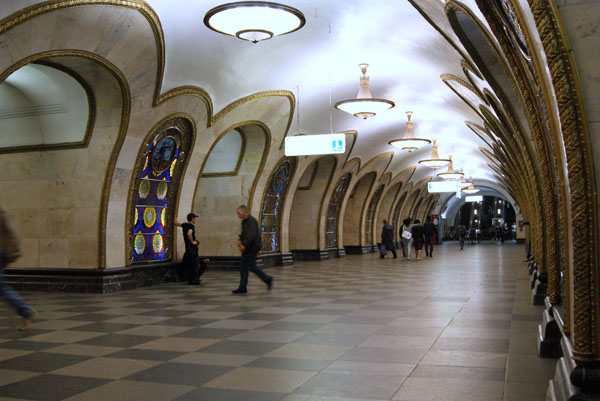
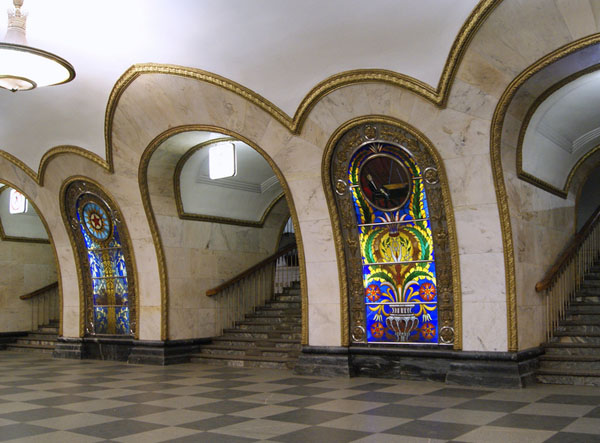
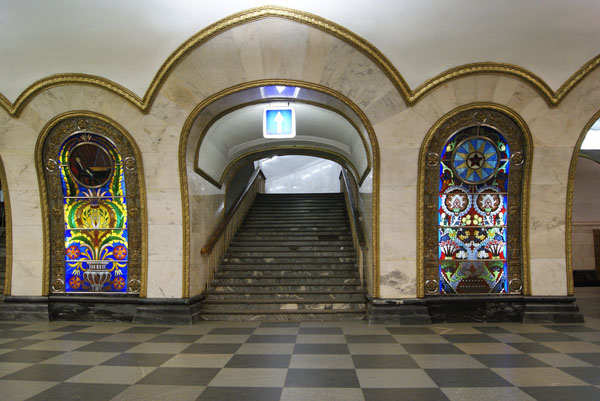
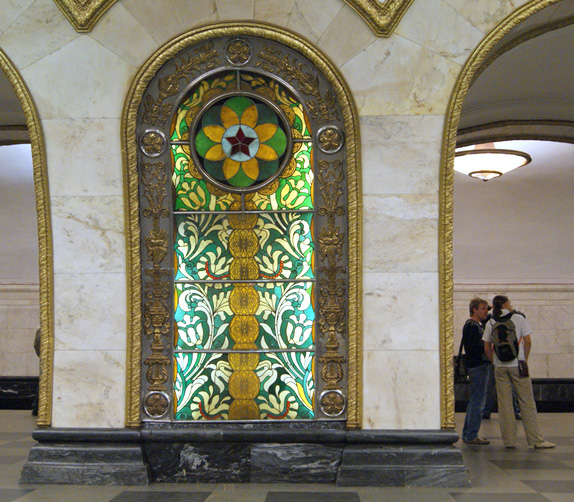
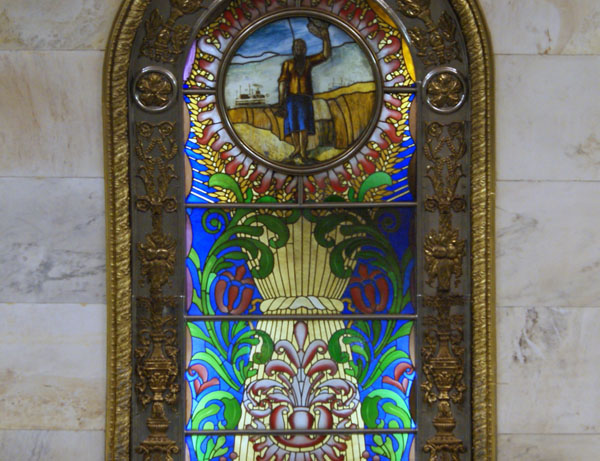
November 27, 2009
Objetos Con Vidrio
This doesn't happen very often, but it is interesting when I come across a blog-post about Tom Krepcio, that is to say, me.
My first reaction is to observe that some extended effort went into making this. The images are from the 'works in progress' section of my website and the block of text from a totally different part, from my 'Vitreobiography, part 1'. On top of that, there is the effort put into translating my text to Spanish. So, I am quite flattered that this much effort was put into a post about my work.
Vanity aside, Objetos con Vidrios is quite an interesting blog. There are very few blogs on glass art and this one is very very good. Go and browse.
November 26, 2009
AGG Call for Papers - one week to go
From the American Glass Guild -
The mission of the AGG is to provide an open forum for the exchange of information on stained, leaded and decorative glass and its creation, preservation, restoration, and history. Our intention is to work toward building an environment within the field that both cultivates novices and facilitates experienced artists and craftspeople to attain a higher level of expertise. Our well-received conferences include presentations, round-table discussions, and demonstrations by notable national and international experts. Information on past conferences is available on our website at http://www.americanglassguild.org.
Abstracts for the 2010 Conference in Detroit should be submitted by email to info@americanglassguild.org by December 4, 2009. They should include a title and be no longer than 300 words. Authors should include a bio and full contact information for themselves (name/company, mailing address, phone, fax, website, and email address) and if a panel is proposed, for the other panel members.
If your proposal is accepted, all travel and hotel expenses are the responsibility of the presenter(s). Those giving 40-minute talks receive one free registration for the conference (to be split if there are two presenters) and those giving 20-minute talks receive one free half-registration. Those organizing and leading panel discussions receive one half-registration. The panelists receive Conference Post-prints and a T-shirt. To receive these benefits, presenter(s) must register for the conference.
The program committee will send notification of acceptance by January 5, 2010. We will publish a Post-print of the presentations. Past years conference Pre and Post-prints are available on the AGG website.
Questions or comments should be directed by email to info@americanglassguild.org. We also welcome suggestions for topics on which you would like to hear presentations. Please feel free to distribute this announcement to any interested colleagues. We look forward to seeing you in Detroit!
November 24, 2009
November 18, 2009
La Gazza Ladra
Been crazy busy recently so little posting. So I'll build on a previous post I wrote in April about the 'stained glass-like' artist Emmanuelle Luzzati.
I've found his most 'stained glassy' looking film. La Gazza Ladra, 1965. It's also the first Luzzati/Giannini film I ever saw, and it's still my favorite. The name translates as "The Theiving Magpie", and the music is an overture by Gioachino Rossini.
And yes, one of the reasons I do like this is that it is his most stained glassy and there are any number of frames that could easily be translated to stained glass.
November 07, 2009
Salem Stained Glass on UNC-TV
Just appearing on YouTube today is this video about Salem Stained Glass, produced by Our State Magazine and shown on UNC-TV.
Serious flashbacks for me since this is the studio I worked for from 2001-2004, most of that time as production manager. Basically, I helped them move from their older smaller location in Winston-Salem to the new larger facility you see in the video. I also set up the computer generated design part of the business. You can see in the video that the designs are in Adobe Illustrator, my preferred computer software for stained glass design. They are probably still doing variations on designs I initially set up 5 years ago. The plotter was not there in my time, though I wish it had been.
Good people doing good works. Nice to see them getting some good professional quality PR.
November 06, 2009
ReadyMade talks to Judith Schaechter
Nice post on the ReadyMade website called Stained Glass in Philadelphia: A Visit With Judith Schaechter in Sad City
There is also a 4 minute video where Judith shows off her layering techniques. I tried to embed the video, but it didn't play well. In fact it almost locked up my whole computer. I can only guess they uploaded a video without compression or something similar. Anyway, here is the link to Ready To Wear's Judith Schaechter YouTube video.
November 03, 2009
Earthship Houses on Fry in America
This is a segment from the documentary series Stephen Fry In America. In this segment Stephen visits the earthship houses of New Mexico, and talks with the architect Michael Reynolds.
There is no specific reference to the stained glass quality of the bottle walls, as they only talk about the sustainablity issues of earthship houses. Yet there are many shots of bottle walls throughout the piece, some of them utilizing the transmitted light and some not.
The Earthship segment is from 2:15 to 6:45.